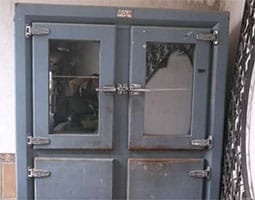 The etymology of refrigerator takes us to the Latin word frigorifĭcus , which refers to that which cools. The chamber , device or appliance that generates cold to allow the preservation of food and other elements is called a refrigerator.
The etymology of refrigerator takes us to the Latin word frigorifĭcus , which refers to that which cools. The chamber , device or appliance that generates cold to allow the preservation of food and other elements is called a refrigerator.
A refrigerator, therefore, can be an industrial facility intended for the storage of vegetables, fruits or meats at low temperatures . These products are placed in a refrigerator until they are distributed and marketed: in this way, given that they are perishable foods, they are prevented from spoiling before reaching the hands of consumers.
When the meat obtained after the slaughter of an animal is left at room temperature, it is attacked by microorganisms that degrade the tissues. If this action progresses, the meat rots and is no longer edible. On the other hand, when the meat is placed in a refrigerator at a low temperature, the microorganisms cannot act in the same way and the deterioration is interrupted.
Beyond meat, fruits, vegetables, flowers and eggs are also often stored in refrigerators. Temperature and humidity conditions vary according to the needs of each product.
It is important to mention that, in some regions , the notion of refrigerator refers to the device that in other places is known as a refrigerator , refrigerator , refrigerator or ice cream maker . It is a device present in all homes as it is used to store food at a low temperature, delaying its degradation.
Generally these refrigerators have a compartment with a temperature between 2° and 6° C. They may also have an additional space called a freezer or freezer , whose temperature is -18 °C .
History of the domestic refrigerator
 Although nowadays it is almost impossible for us to do without a refrigerator at home, and for that reason we take for granted that we will always have a place to store our perishable foods, we must not forget that until almost three centuries ago people did not have this appliance and had to look for other ways to preserve its products.
Although nowadays it is almost impossible for us to do without a refrigerator at home, and for that reason we take for granted that we will always have a place to store our perishable foods, we must not forget that until almost three centuries ago people did not have this appliance and had to look for other ways to preserve its products.
It is true that many people eat ingredients that they collect directly from their natural environment and do not require artificial refrigeration , but there are also those who make periodic purchases in the market and then store dozens of different products in the refrigerator to prevent them from rotting. . In the past, to overcome the lack of this appliance, certain very cold caves were ideal, although deep wells were also used where large quantities of ice were poured.
These and other conservation methods led to the invention of the so-called ice houses , a space that was usually built near a water reserve. There, the natural ice and snow of the coldest seasons were used to refrigerate food during the rest of the year. Time passed and at the beginning of the 19th century, engineer Thomas Moore , born in the United States, created the first version of the domestic refrigerator, which was based precisely on the concept of an ice house.
Moore's home refrigerator was a heat-insulating chamber that required a load of ice blocks to cool food. Half a century earlier, the Scottish physicist William Cullen had found the formula to create a cold pack, something that Oliver Evans , an American inventor , took advantage of in 1805 to design a more advanced refrigerator, based on vapor compression, although not was successful. Almost three decades passed until another scientist, also an American Jacob Perkins , invented and patented the first refrigerator model based on the discoveries of Cullen and Evans. Another important contribution came in 1844, when the doctor John Gorrie managed to surpass the efficiency of the Perkins model.
